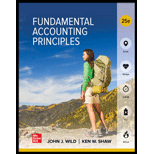
(1)
Introduction: The financial statements of a company include a
To identify: The amount for Company A.
(2)
Introduction: The financial statements of a company include a balance sheet, income statement, and cash flow statement. All these statements help the internal and external users of financial statements help in analyzing and concluding the financial position of the respective company.
To identify: The amount for Company B.
(3)
Introduction: The financial statements of a company include a balance sheet, income statement, and cash flow statement. All these statements help the internal and external users of financial statements help in analyzing and concluding the financial position of the respective company.
To identify: The amount of ending assets for Company C.
(4)
Introduction: The financial statements of a company include a balance sheet, income statement, and cash flow statement. All these statements help the internal and external users of financial statements help in analyzing and concluding the financial position of the respective company.
To identify: The number of owner investments for Company D.
(5)
Introduction: The financial statements of a company include a balance sheet, income statement, and cash flow statement. All these statements help the internal and external users of financial statements help in analyzing and concluding the financial position of the respective company.
To identify: The number of beginning liabilities for Company E.
Want to see the full answer?
Check out a sample textbook solution
Chapter 1 Solutions
FUND.ACCT.PRIN.
 Financial Accounting: The Impact on Decision Make...AccountingISBN:9781305654174Author:Gary A. Porter, Curtis L. NortonPublisher:Cengage Learning
Financial Accounting: The Impact on Decision Make...AccountingISBN:9781305654174Author:Gary A. Porter, Curtis L. NortonPublisher:Cengage Learning College Accounting, Chapters 1-27 (New in Account...AccountingISBN:9781305666160Author:James A. Heintz, Robert W. ParryPublisher:Cengage Learning
College Accounting, Chapters 1-27 (New in Account...AccountingISBN:9781305666160Author:James A. Heintz, Robert W. ParryPublisher:Cengage Learning Intermediate Accounting: Reporting And AnalysisAccountingISBN:9781337788281Author:James M. Wahlen, Jefferson P. Jones, Donald PagachPublisher:Cengage Learning
Intermediate Accounting: Reporting And AnalysisAccountingISBN:9781337788281Author:James M. Wahlen, Jefferson P. Jones, Donald PagachPublisher:Cengage Learning Financial And Managerial AccountingAccountingISBN:9781337902663Author:WARREN, Carl S.Publisher:Cengage Learning,
Financial And Managerial AccountingAccountingISBN:9781337902663Author:WARREN, Carl S.Publisher:Cengage Learning,




